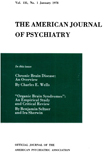ELECTROSHOCK THERAPY IN HIGH-RISK PATIENTS
Abstract
The use of the procedure as practiced by the authors for allaying apprehension and reassuring the patient and physician is not considered a trivial indication. In the cases where we have used it for this purpose, it was probably one of the determining factors as to whether the patient would accept treatment on not. Secondly, the distressing muscular fasciculations and paralyses produced by the succinylcholine can lead the apprehensive patient to withdraw from treatment once begun. It must also be noted that in all of the cases where a decision is made to treat the patient in this manner, there is reassurance not only to the patient but to the physician, who must bear the responsibility in any case.
Advantages in using this procedure in selected cases thus appear to outweigh the added expense and inconvenience. The main advantage would appear to be the opportunity to utilize EST in those patients expected to benefit from it coupled with the security the psychiatrist has in giving the treatment to those with an increased risk. It would seem that there is little reason why this procedure should not be extended and used routinely in all patients treated with EST. From maintenance of full oxygenation, hypoxia or anoxia is eliminated along with the risk of fractures or dislocations, thus extending treatment to borderline cases, such as those with cardiac disabilities and orthopedic problems. An added advantage is the freedom to individualize the dose of thiopental or succinylcholine according to the idiosyncratic reactions of certain patients and also to adjust this as treatments progress, which is occasionally needed(9).
Access content
To read the fulltext, please use one of the options below to sign in or purchase access.- Personal login
- Institutional Login
- Sign in via OpenAthens
- Register for access
-
Please login/register if you wish to pair your device and check access availability.
Not a subscriber?
PsychiatryOnline subscription options offer access to the DSM-5 library, books, journals, CME, and patient resources. This all-in-one virtual library provides psychiatrists and mental health professionals with key resources for diagnosis, treatment, research, and professional development.
Need more help? PsychiatryOnline Customer Service may be reached by emailing [email protected] or by calling 800-368-5777 (in the U.S.) or 703-907-7322 (outside the U.S.).



